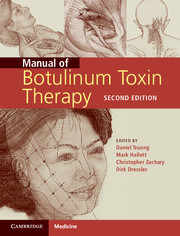Book contents
- Frontmatter
- Dedication
- Contents
- List of Contributors
- Preface
- Chapter 1 The pretherapeutic history of botulinum neurotoxin
- Chapter 2 Botulinum neurotoxin: history of clinical development
- Chapter 3 Pharmacology of botulinum neurotoxins
- Chapter 4 Immunological properties of botulinum neurotoxins
- Chapter 5 Treatment of cervical dystonia
- Chapter 6 Examination and treatment of complex cervical dystonia
- Chapter 7 Ultrasound guidance for botulinum neurotoxin therapy: cervical dystonia
- Chapter 8 Treatment of blepharospasm
- Chapter 9 Botulinum neurotoxin in oromandibular dystonia
- Chapter 10 Treatment of focal hand dystonia
- Chapter 11 Botulinum neurotoxin therapy of laryngeal muscle hyperactivity syndromes
- Chapter 12 The use of botulinum neurotoxin in otorhinolaryngology
- Chapter 13 Treatment of hemifacial spasm
- Chapter 14 Spasticity
- Chapter 15 The use of botulinum neurotoxin in spastic infantile cerebral palsy
- Chapter 16 The role of ultrasound for botulinum neurotoxin injection in childhood spasticity
- Chapter 17 The use of botulinum neurotoxin in spasticity using ultrasound guidance
- Chapter 18 The use of botulinum neurotoxin in tic disorders and essential hand and head tremor
- Chapter 19 Treatment of stiff-person syndrome with botulinum neurotoxin
- Chapter 20 Botulinum neurotoxin applications in ophthalmology
- Chapter 21 Cosmetic uses of botulinum neurotoxins
- Chapter 22 Hyperhidrosis
- Chapter 23 Botulinum neurotoxin A treatment for ischemic digits
- Chapter 24 Botulinum neurotoxin in wound healing
- Chapter 25 Use of botulinum neurotoxin in neuropathic pain
- Chapter 26 The use of botulinum neurotoxin in the management of headache disorders
- Chapter 27 The use of botulinum neurotoxin in musculoskeletal pain and arthritis
- Chapter 28 Treatment of plantar fasciitis with botulinum neurotoxins
- Chapter 29 Use of botulinum neurotoxin in the treatment of low-back pain
- Chapter 30 Use of botulinum neurotoxin in the treatment of piriformis syndrome
- Chapter 31 Ultrasound-guided botulinum neurotoxin injections for thoracic outlet syndrome
- Chapter 32 Botulinum neurotoxin in the gastrointestinal tract
- Chapter 33 Botulinum neurotoxin applications in urological disorders
- Index
- References
Chapter 4 - Immunological properties of botulinum neurotoxins
Published online by Cambridge University Press: 05 February 2014
- Frontmatter
- Dedication
- Contents
- List of Contributors
- Preface
- Chapter 1 The pretherapeutic history of botulinum neurotoxin
- Chapter 2 Botulinum neurotoxin: history of clinical development
- Chapter 3 Pharmacology of botulinum neurotoxins
- Chapter 4 Immunological properties of botulinum neurotoxins
- Chapter 5 Treatment of cervical dystonia
- Chapter 6 Examination and treatment of complex cervical dystonia
- Chapter 7 Ultrasound guidance for botulinum neurotoxin therapy: cervical dystonia
- Chapter 8 Treatment of blepharospasm
- Chapter 9 Botulinum neurotoxin in oromandibular dystonia
- Chapter 10 Treatment of focal hand dystonia
- Chapter 11 Botulinum neurotoxin therapy of laryngeal muscle hyperactivity syndromes
- Chapter 12 The use of botulinum neurotoxin in otorhinolaryngology
- Chapter 13 Treatment of hemifacial spasm
- Chapter 14 Spasticity
- Chapter 15 The use of botulinum neurotoxin in spastic infantile cerebral palsy
- Chapter 16 The role of ultrasound for botulinum neurotoxin injection in childhood spasticity
- Chapter 17 The use of botulinum neurotoxin in spasticity using ultrasound guidance
- Chapter 18 The use of botulinum neurotoxin in tic disorders and essential hand and head tremor
- Chapter 19 Treatment of stiff-person syndrome with botulinum neurotoxin
- Chapter 20 Botulinum neurotoxin applications in ophthalmology
- Chapter 21 Cosmetic uses of botulinum neurotoxins
- Chapter 22 Hyperhidrosis
- Chapter 23 Botulinum neurotoxin A treatment for ischemic digits
- Chapter 24 Botulinum neurotoxin in wound healing
- Chapter 25 Use of botulinum neurotoxin in neuropathic pain
- Chapter 26 The use of botulinum neurotoxin in the management of headache disorders
- Chapter 27 The use of botulinum neurotoxin in musculoskeletal pain and arthritis
- Chapter 28 Treatment of plantar fasciitis with botulinum neurotoxins
- Chapter 29 Use of botulinum neurotoxin in the treatment of low-back pain
- Chapter 30 Use of botulinum neurotoxin in the treatment of piriformis syndrome
- Chapter 31 Ultrasound-guided botulinum neurotoxin injections for thoracic outlet syndrome
- Chapter 32 Botulinum neurotoxin in the gastrointestinal tract
- Chapter 33 Botulinum neurotoxin applications in urological disorders
- Index
- References
Summary
Introduction
Botulinum neurotoxins (BoNTs) are used to treat a large number of muscle hyperactivity disorders including dystonia, spasticity, tremor and autonomic disorders (e.g. hyperhidrosis and hypersalivation), as well as facial wrinkles. Commercially available products differ with respect to serotype, formulation and purity. Not all products are approved in all countries. Serotype A-containing products are Botox (onabotulinumtoxinA), Dysport (abobotulinumtoxinA) and Xeomin (incobotulinumtoxinA), whereas NeuroBloc/MyoBloc (rimabotulinumtoxinB) contains serotype B. The active ingredient in all products is BoNT, a two-chain protein with a molecular weight of 150 kDa. BoNT type A (BoNT-A) inhibits release of the neurotransmitter acetylcholine by cleaving synaptosomal associated protein-25, a SNARE protein, while BoNT type B (BoNT-B) cleaves synaptobrevin (vesicle-associated membrane protein-2).
Since BoNTs are foreign proteins, the human immune system may respond to them with the production of specific anti-BoNT antibodies. The probability of developing such antibodies increases with the BoNT doses applied (Göschel et al., 1997; Lange et al., 2009). Whether other drug-related factors might contribute to immune responses is discussed below. Patient-related factors may also be involved in triggering antibody formation to BoNT. Recently, a patient was reported who was treated with abobotulinumtoxinA for several years with good results until he developed anti-BoNT-induced therapy failure after he received BoNT following a wasp sting (Paus et al., 2006). Since components of wasp poison are effective immunostimulants, a preactivation of lymphocytes may have triggered antibody formation against BoNT-A. In the following, a method is presented for the quantification of anti-BoNT in sera; the immune cell reactions to antigens are described and drug-related immune responses are discussed.
Information
- Type
- Chapter
- Information
- Manual of Botulinum Toxin Therapy , pp. 16 - 21Publisher: Cambridge University PressPrint publication year: 2014
